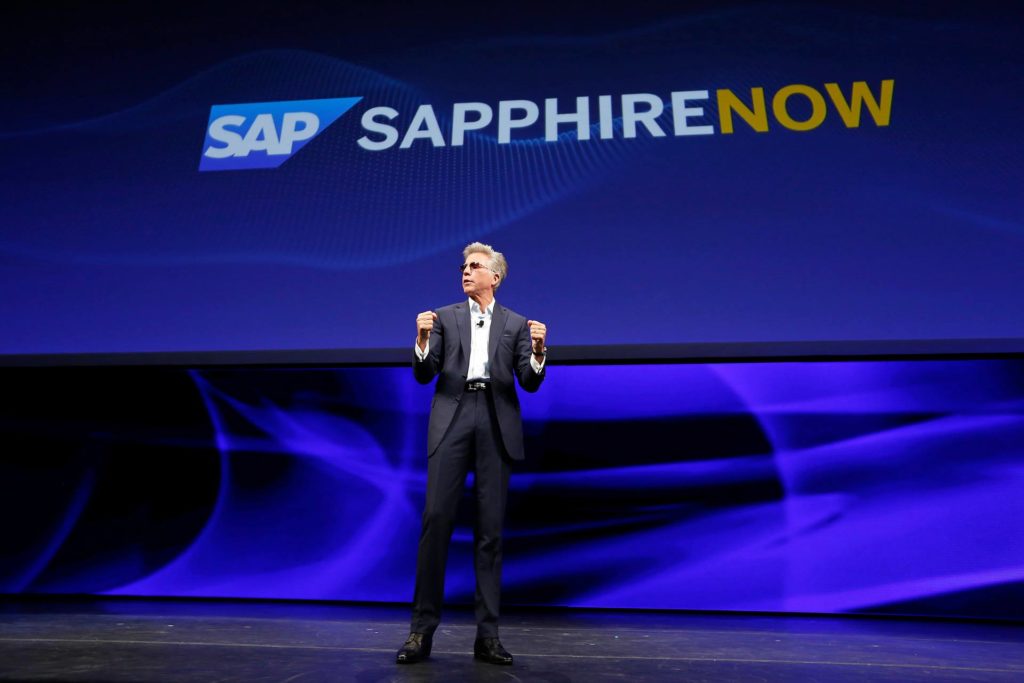As SAP prepares to roll out the future of the intelligent enterprise at Sapphire over the next few days, here are 10 timely perspectives to help you understand where the company stands today, where it’s headed, and why it expects to outperform its competitors.
1. SAP’s financial position has never been stronger.
To compete and win on a global scale in the Cloud Wars takes more than exceptional technology, and SAP can boast the strongest financial momentum it’s ever had. For Q1, revenue across on-premises and cloud was up 16%, and combined order-entry for new cloud and software-license business was up 17%. New cloud bookings were up 32% versus the year-earlier quarter, and software-license revenue was up 4% year-over-year. That across-the-board performance is reflected in SAP’s unprecedented market cap of about $153 billion.
2. SAP’s growing much faster in the cloud than Salesforce and Workday, CEO Bill McDermott happily pointed out.
Early in his opening remarks on SAP’s April 24 earnings call, McDermott offered this perspective on growth rates in the cloud: “Looking at our peer-group comparisons, SAP is growing faster than our competitors in the core and in the cloud. The 48% growth in SAP’s total cloud revenue is 22 points faster than Salesforce, which is growing at 26%. This is equivalent to an 80% higher growth rate. And it’s 10 points faster than Workday, which is growing at 37.5%, equivalent to a 30% higher growth rate than Workday.”
3. SAP’s eager to pursue an emerging $400-billion market.
“We’re perfectly positioned to capitalize on major secular trends such as the move to the cloud, digital transformation, Industry 4.0 and business-process automation driven by AI and ML,” said McDermott. Those trends, he said, “contribute to a total addressable market of more than 350 billion Euros growing in double-digits.”
4. While Qualtrics has grabbed most of the recent attention around SAP, HANA continues to gain wide acceptance.
SAP’s modern S/4HANA ERP system now has almost 11,000 customers, up 30% year-over-year. And the new C/4HANA customer-experience suite is growing at more than 100%, with Q1 revenue of $340 million. “Only SAP can connect demand to fulfillment engine in one end-to-end value chain,” McDermott said on the earnings call.
5. Delivering great customer experiences: helping CEOs move from wishing and hoping to brilliant execution.
While 80% of CEOs believe (hope? wish?) that they’re delivering superior experiences to customers, only 8% of customers feel they’re getting that type of treatment, McDermott said. And SAP believes that with its acquisition of Qualtrics, it can fuse those experience insights gleaned from Qualtrics’ applications to the operational knowledge and insights of SAP’s other applications to close that perception/reality gap for CEOs. McDermott later offered CVS as an example of such an experience-based transformation.

“CVS realized that if we’re looking at our systems of record—whether Human Capital Management, Customer Relationship Management, Manufacturing—while I have all that O-data, I never knew why customers were receiving my products well, or buying more, or buying less. Or why one country was doing this and another country was doing the other thing. All of this now can be coalesced in a digital boardroom that composes both the experience and the operational data. And it’s really exciting to CEOs who are trying to run companies.”
6. SAP believes it can deliver “experience intelligence” across all facets of the enterprise.
“Combining X-data with O-data powered by HANA in real time in the cloud gives you experience intelligence,” McDermott said on the earnings call. SAP plans to embed that type of experience intelligence within all LOB applications running on HANA “from customer experience to product experience to employee experience.” He later offered this example of how that could apply in HR: “We can take the whole value chain now on the experience data of an employee. ‘How do you feel about the recruiting experience, the onboarding experience? How’s your training going? What do you think of the compensation plan and bonus?’ ” McDermott said.
“All this experience data now comes into the HR system through HANA instantaneously so that as a manager you’re not just looking at data because the system’s now telling you exactly what the Big Data is saying. And it’s making predictions on the business decisions you as a leader should be taking. The same is true with your customers externally, and the same is true on product feedback or even how your brand’s resonating in all of the channels in today’s open Internet market.”
7. Businesses need to move past customer surveys to systems of action.
Jen Morgan, president of SAP’s Cloud Business Group, added this perspective on the call about the need for executives to go beyond survey data to appropriate and high-impact action:
“Every company out there has tons of survey data, but our customers are looking for a platform. And what we’re able to do is take the experience we have in industries and the experience we have in business processes, overlay that experience platform across those processes, and then really be able to see where experience becomes a leading indicator to drive a different outcome. And then to talk about where does that show on the top line? Where does it show up in your SG&A improvements? So we’re turning this from talking about surveys to talking about a platform that drives results on the income statement.”
8. SAP’s internal focus on operational excellence: leaner and smarter.
In describing the company’s own experience with becoming an intelligent enterprise, McDermott said the new reality of data-driven and customer-centric business will allow SAP to do without traditional layers of middle management. “When we bring people into this company, they will code software or they will be on the very front lines with the customer relationships,” he said. “We don’t need the middle layers—we already have enough and our HANA software can give us all the insights we need. So you’re not going to see us bringing in middle management and thick layers in this company—people are going to be writing software and people are going to be back customer relationships in the field.”
9. Refining SAP’s relationships with the cloud hyperscalers to drive more customer value.
From Jen Morgan: “One of the things we worked through really hard over the last year is defining the reference architecture for hyperscalers [Microsoft Azure, AWS, Google Cloud] by industry. We worked very closely with each of them so we can be much more prescriptive with the customers,” Morgan said.
“For example: what is the optimal reference architecture for a business to move to S/4? What’s the optimal set of cloud properties to help our customers making that move with regard to orchestration, integration and extension of an SAP system? That will do two things: drive S/4 in that revenue stream, and also drive further cloud revenue for us from our cloud platform. So that’s a win-win for our customers who’ve asked us to come together and help them with that… And it’s a win-win for the hyperscalers but most importantly it’s a win-win for the customers.”
10. The significance of moving SuccessFactors from Oracle Database to HANA.
On the earnings call, CFO Luka Mucic described the impact of migrating the entire SuccessFactors customer base over to SAP’s own HANA database.
“Just to give you an idea of the scale of what we have been moving here, we have moved thousands of customers and more than one petabyte of customer data as part of the migration.” By moving more than 90,000 customer reports to the new environment, Mucic said, SAP will now be able to accelerate innovation in SuccessFactors by leveraging the underlying power of HANA. In addition, he said, “We’ll obviously see an expense relief as we can now retire duplicate infrastructures, reduce third-party support fees and reallocate resources previously working on the migration.”
Disclosure: at the time of this writing, SAP was a client of Evans Strategic Communications LLC.
Subscribe to the Cloud Wars Newsletter for in-depth analysis of the major cloud vendors from the perspective of business customers. It’s free, it’s exclusive, and it’s great!








